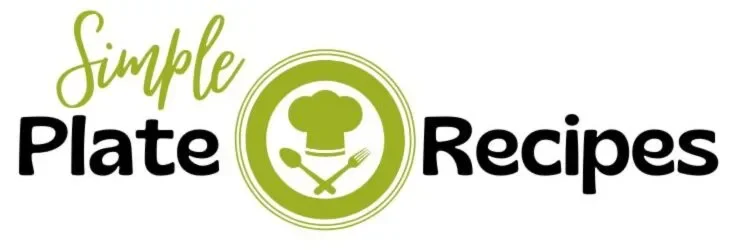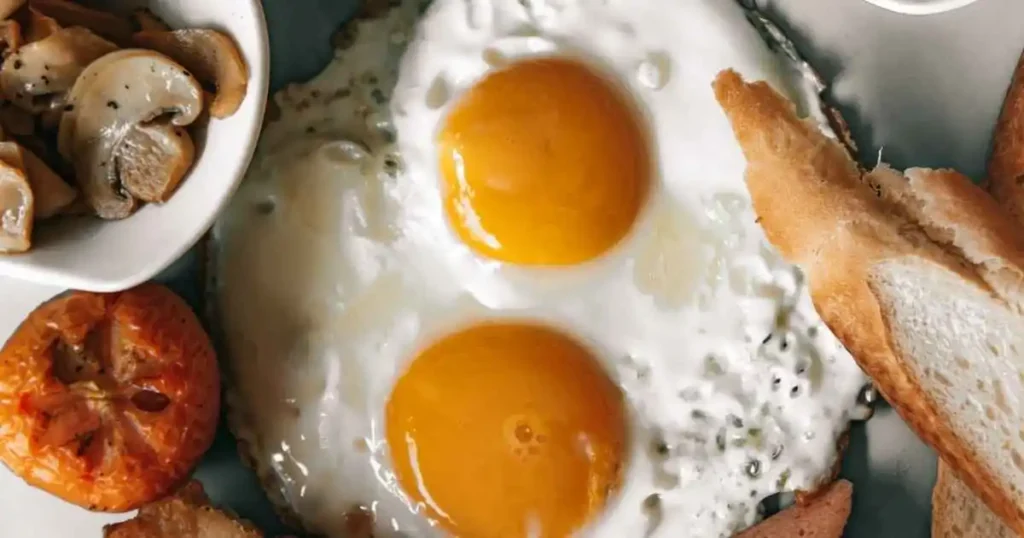The smell of sizzling butter and the crunch of a perfectly cooked egg white are unbeatable. As a breakfast lover, I’ve tried many eggs. But making over hard eggs is a skill that changes everything.
These eggs are great for breakfast, sandwiches, or adding protein to any meal. They’re versatile and delicious.
In this guide, I’ll share my secrets for perfect over hard eggs. You’ll learn how to pick the freshest ingredients and get the temperature and flip just right. You’ll become an expert at making the most satisfying, fully cooked yolks.
Understanding Over Hard Eggs
Over hard eggs are a key part of cooking, known for their fully cooked whites and yolks. They are different from over-easy and over-medium eggs, which have runnier yolks. Knowing how to make over hard eggs can open up new culinary techniques for your kitchen.
1.What Makes an Egg Over Hard
Over hard eggs are cooked on both sides until the yolk is fully set. This makes the center firm and hard-cooked. In contrast, over-easy eggs have a runny yolk, and over-medium eggs have a slightly soft yolk.
2.Difference from Other Egg Styles
- Over-easy eggs: Cooked on both sides with a runny yolk and fully cooked whites.
- Over-medium eggs: Partially cooked yolk with fully cooked whites.
- Over hard eggs: Fully cooked yolk and whites, with no runny yolk.
3.Benefits of Over Hard Eggs
Over hard eggs are easy to handle, especially in restaurant lingo and culinary techniques like sandwiches. Their fully cooked yolk means less chance of a mess. They also fit into many diets, like gluten-free, dairy-free, keto, and paleo.
While all eggs have similar nutrition, over hard eggs are firmer. This makes them good for those who want a less messy egg or follow certain diets. Understanding over hard eggs can help you use this staple in your cooking.
Essential Equipment and Ingredients
To make delicious over hard eggs, you need the right cooking utensils and kitchen tools. You’ll want a few key items to get the perfect texture and taste.
A non-stick or well-seasoned cast iron skillet is a must. It makes sure the eggs slide off easily, avoiding any sticking or tearing. Also, a thin and wide rubber spatula is great for flipping the eggs gently without messing up their shape.
For the best egg quality, go for fresh, large, high-quality eggs. You’ll also need a fork to lightly break the yolks once the eggs are cooked.
Choose from butter, olive oil, or a neutral oil like vegetable or avocado oil for cooking. These oils help make the eggs golden-brown and prevent sticking.
Remember to have your seasonings ready, like salt and pepper. They add the perfect flavor to your over hard eggs.
| Equipment | Ingredients |
|---|---|
|
|
With the right cooking utensils and kitchen tools, and top-notch egg quality, you’re ready to make amazing over hard eggs.
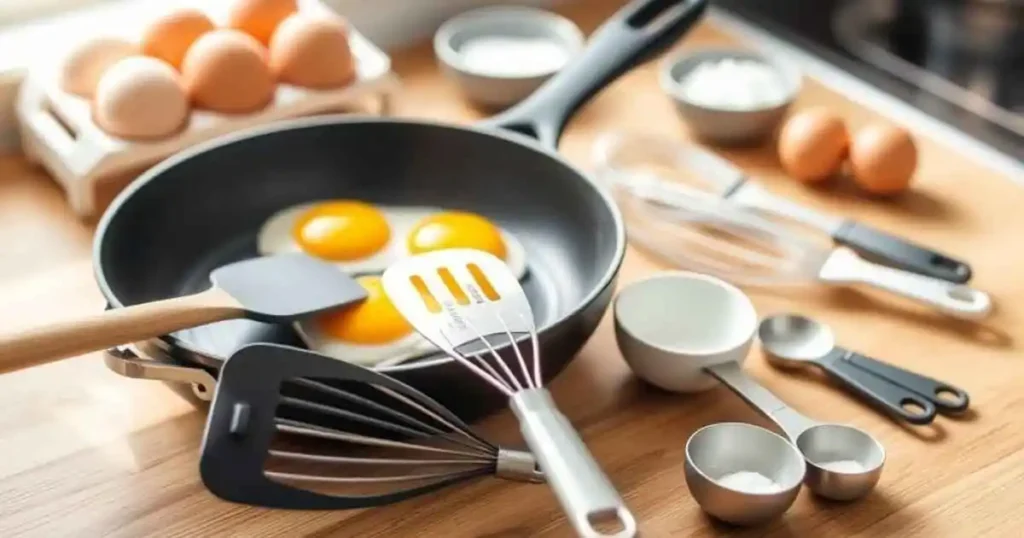
Selecting the Right Pan for Perfect Results
Choosing the right cookware is key to cooking perfect over-hard eggs. Non-stick and cast iron skillets are top picks. Each has its own benefits for egg cooking.
1. Non-stick vs. Cast Iron Options
Non-stick pans are great for frying eggs because they prevent sticking. This makes flipping eggs easy. They have a special coating that lets eggs slide out smoothly.
Cast iron skillets, on the other hand, distribute heat well. This ensures your eggs cook evenly and get a nice texture.
2. Pan Size and Heat Distribution
The size of your kitchen equipment matters for perfect over-hard eggs. The pan should fit the number of eggs you’re cooking without being too crowded. An 8-inch to 10-inch pan is ideal for a few eggs at once.
It’s also important to control the heat well. A pan that heats evenly prevents hot spots. This ensures your eggs cook the same way. Whether you pick non-stick or cast iron, watch the heat closely to get your eggs just right.
The Importance of Fresh Eggs
Fresh eggs are key to making perfect over hard eggs. They hold their shape better and taste better than older eggs. The whites are firmer, and the yolks are bright and vibrant.
Crack eggs on a flat surface before adding them to the pan. This prevents shell fragments from getting into your dish. If using older eggs, use a spatula to pull the whites towards the center as they cook.
The USDA grades eggs based on shell quality, air cell depth, and white firmness. Grade AA eggs are best for over hard eggs because they keep their shape and texture. Choose large or extra-large eggs for the best results.
Proper storage is also important for egg quality. Keep eggs refrigerated at 40°F or below. Use them within 3-4 days for the best food freshness and cooking ingredients. Starting with fresh eggs will help you master over hard eggs.
Mastering the Heat Level
To get over hard eggs just right, you need to control the temperature carefully. Cook them on medium-low heat, about 2.5-3 on a scale of 1 to 10. This method keeps the eggs from burning or getting rubbery. It also makes sure the whites are set and the yolks are cooked just right.
1. Temperature Control Tips
- Preheat your pan over medium-low heat for a few minutes before adding the eggs.
- Use a non-stick skillet or a well-seasoned cast iron pan to help maintain even heat distribution.
- Adjust the stovetop settings as needed to keep the temperature consistently medium-low throughout the cooking process.
- Monitor the eggs closely, adjusting the heat as necessary to prevent overcooking or burning.
2. Common Heat-Related Mistakes
- Using too high heat, which can lead to overcooked, rubbery eggs or burnt bottoms with undercooked tops.
- Failing to preheat the pan properly, resulting in uneven cooking and potential sticking.
- Not adjusting the heat throughout the cooking process, leading to inconsistent results.
- Overcrowding the pan, which can cause the eggs to steam rather than cook properly.
Mastering heat management is key to cooking over hard eggs perfectly. With practice, you’ll get the cooking temperature just right. This will give you eggs with firm, golden yolks and fully set whites every time.
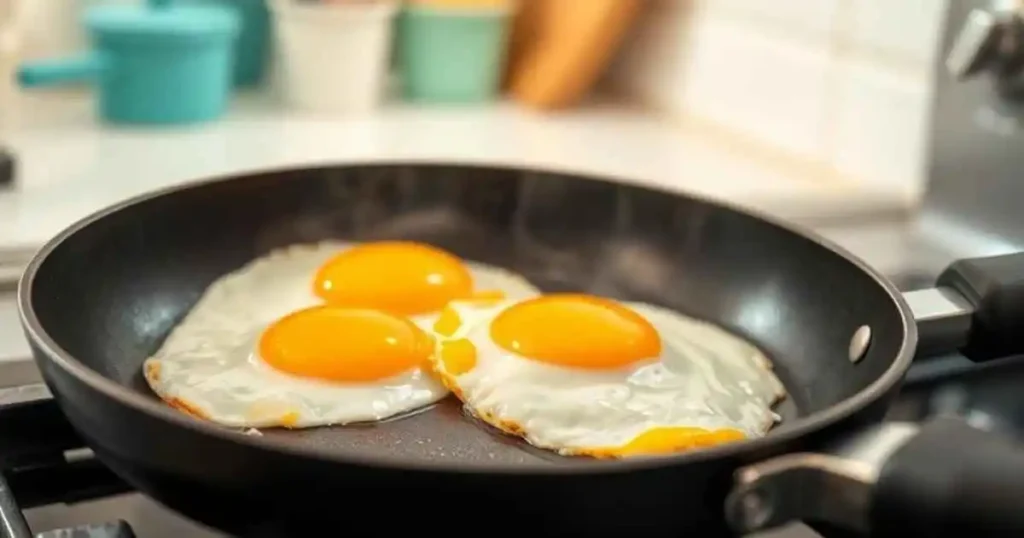
| Cooking Temperature | Stovetop Settings | Heat Management Tips |
|---|---|---|
| Medium-Low | 2.5-3 out of 10 |
|
By following these tips and avoiding common mistakes, you’ll master over hard eggs in no time.
Step-by-Step Guide to Over Hard Eggs
Learning to make over hard eggs is all about technique and detail. Follow this guide to get better at cooking eggs in your kitchen.
- First, heat a non-stick pan or cast iron skillet over medium-low heat. Add a bit of butter or oil to the pan.
- Crack the egg right into the hot pan, being careful not to break the yolk.
- Use a fork to gently break the yolk. This helps it cook evenly with the egg white.
- Cook the egg for 4-5 minutes, watching the heat closely to avoid overcooking.
- Flip the egg with a spatula and cook for another 1-2 minutes. This makes the yolk fully set.
- Take the egg out of the pan and add your favorite spices or toppings.
To get over hard eggs with a firm yolk, keep the heat steady. This method makes sure the egg whites are set and the yolk is just right.
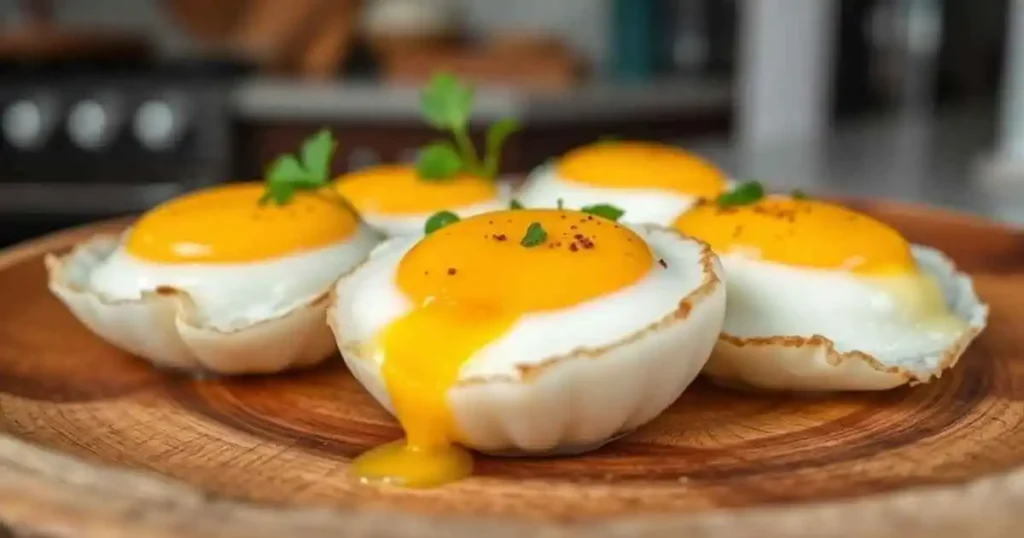
The cooking time can change based on egg size and pan type. Adjust the heat and time to get your eggs just right.
With a bit of practice, you’ll get the hang of making over hard eggs. Enjoy perfectly cooked eggs every time.
Cooking Fats and Their Effects
Choosing the right cooking fat is key when making over hard eggs. Butter gives a rich, savory taste. Olive oil adds a slightly bitter note. For a neutral taste, cooking oils like canola or vegetable oil are great.
1. Butter vs. Oil Comparison
Butter is loved for its unique flavor but has more saturated fat. Olive oil is healthier but can taste slightly bitter. Neutral oils like canola or vegetable let the egg’s natural taste stand out.
2. Dairy-Free Alternatives
- Coconut oil adds a subtle coconut flavor to eggs.
- Avocado oil is a healthy, dairy-free choice with lots of monounsaturated fats.
- Refined avocado or grapeseed oil are neutral and perfect for enhancing flavor without adding taste.
Choosing the right cooking fat depends on what you like and your diet. Try different cooking oils to find the best taste and health for your over hard eggs.
Perfecting the Flip Technique
Mastering the flip technique is key to cooking over hard eggs. It can turn a simple dish into a masterpiece. With practice, you’ll flip eggs like a pro, impressing everyone with your cooking skills.
A thin, wide rubber spatula is the best tool for flipping eggs. It slides under the egg without scratching the pan. Slide the spatula under the egg, then lift and flip it in one smooth motion.
- Slide the thin, wide rubber spatula under the egg, making sure it’s fully supported.
- Lift the egg up in one smooth motion, avoiding any jerky movements.
- Flip the egg over, aiming to land it gently back in the pan.
Don’t worry if you’re not perfect at first. Practice makes perfect with egg flipping. Each try will make you more confident and skilled.
Remember, the secret to perfect over hard eggs is controlling the temperature and technique. Follow these tips and practice your kitchen tips. Soon, you’ll be making perfect over hard eggs that will wow everyone.
Seasoning and Flavor Enhancements
Turning your over hard eggs into something special is all about the seasoning. A simple sprinkle of salt and pepper is a good start. But there’s a whole world of flavors waiting to be discovered.
1. Basic and Advanced Seasoning Options
Start with the basics: salt and fresh black pepper. For a bit of heat, add chili flakes or garlic powder. For a fresh taste, try dill, basil, or a bit of pesto.
For something different, try everything bagel seasoning or Old Bay. These unique blends add a rich, complex flavor to your eggs.
2. Herb and Spice Combinations
Herbs and spices offer endless options. Mix rosemary and thyme for a savory taste. Or, try cilantro and lime zest for a bright, citrusy flavor.
Season at different times: before cooking, during the flip, and after. This lets the flavors blend beautifully.
With a bit of experimentation, you’ll make over hard eggs that are not just perfect but also full of flavor. So, don’t be shy to try new things and become your own culinary artist.
Storage and Make-Ahead Tips
While fresh eggs are always best, you can make over hard eggs ahead of time and store them for later. After cooking, let the eggs cool to room temperature. Then, refrigerate them in an airtight container. Stored properly, these eggs can last up to 4 days in the fridge.
When you’re ready to enjoy your make-ahead over hard eggs, simply reheat them. You can use the microwave, oven, or stovetop. Be careful not to overcook them, as this can make them rubbery. Warm the eggs gently until they’re hot all the way through, keeping their tender, creamy texture.
Storing and reheating over hard eggs is a great way to meal prep and reduce food waste. Cooking extra portions in advance means you have a quick, protein-packed breakfast or snack ready whenever you need it. Just remember to handle your food storage and meal prep carefully to keep your leftovers fresh and tasty.
| Egg Storage Tips | Reheating Methods |
|---|---|
|
|
Serving Suggestions and Pairings
Over hard eggs offer endless serving options. They can turn any meal into a delightful experience. Whether it’s a hearty breakfast or a protein-rich lunch, they make any breakfast foods, meal combinations, and egg dishes better.
Begin your day with over hard eggs on toasted bread, hash browns, or sautéed veggies. They’re also great on breakfast sandwiches, bagels, and English muffins. Try them with creamy avocado toast or fluffy cottage cheese pancakes for a nutritious meal.
But over hard eggs aren’t just for breakfast. They can also spice up lunch and dinner. Add them to salads, grain bowls, or on top of a hearty pot roast hash for a satisfying meal.
Serving Suggestions:
- Over hard eggs with toast, hash browns, or sautéed veggies
- Breakfast sandwiches, bagels, or English muffins with over hard eggs
- Avocado toast or cottage cheese pancakes with over hard eggs
- Over hard eggs in salads, grain bowls, or on top of pot roast hash
Over hard eggs can make any breakfast foods, meal combinations, and egg dishes more delicious. Try different pairings to find your favorite way to enjoy them.
I’m excited to share this over hard eggs recipe with you, hoping it will become a cherished tradition.
Conclusion
Learning to cook over hard eggs opens up a world of possibilities. With practice, you’ll make perfect over hard eggs every time. This will impress your family and friends with your egg cooking skills.
Using fresh ingredients and managing heat well are key. Paying attention to cooking times is also important. This will help you succeed in cooking over hard eggs.
Whether you’re new to cooking or experienced, improving your over hard egg skills will make you better. You’ll learn to make the eggs golden brown and the yolk firm. The steps in this guide will help you become an expert.
Don’t be afraid to try new things. Experiment with different fats and seasonings. Enjoy the feeling of serving perfect over hard eggs.
Egg cooking, breakfast prep, and culinary skills are all important for a home chef. Mastering over hard eggs will not only add to your breakfast options. It will also show your dedication to improving your cooking.
Start your journey and let your over hard egg skills shine. Every bite will be delicious.
Frequently Asked Questions
What are over hard eggs?
Over hard eggs have a fully cooked yolk, like a hard-boiled egg. They’re great for those who don’t like runny yolks. They’re perfect for fried egg sandwiches.
How do over hard eggs differ from other egg styles?
Over hard eggs have fully cooked whites and yolks. This is different from over-easy (runny yolk) and over-medium (slightly runny yolk) eggs.
What are the benefits of over hard eggs?
Over hard eggs are easy to handle in sandwiches and make less mess. They’re good for many diets like gluten-free, dairy-free, keto, and paleo. They’re versatile and can be used in many dishes without worrying about spilled yolks.
What essential equipment is needed for making over hard eggs?
You’ll need a non-stick or well-seasoned cast iron skillet, a thin rubber spatula, and a fork. You’ll also need fresh eggs, cooking fat (butter, olive oil, or neutral oil), and seasonings like salt and pepper.
What type of pan works best for over hard eggs?
Use a non-stick pan or a well-seasoned cast iron skillet. Non-stick pans prevent sticking and make flipping easier. Cast iron provides even heat distribution.
Why are fresh eggs crucial for over hard eggs?
Fresh eggs hold their shape better when cracked into the pan. Older eggs tend to spread. If using older eggs, use a spatula to pull the whites towards the center.
What is the ideal heat level for cooking over hard eggs?
Cook over hard eggs on medium-low heat, around 2.5-3 on a scale of 1 to 10. Low and slow cooking prevents burning and ensures even cooking of both whites and yolks.
What is the step-by-step process for making over hard eggs?
1. Melt butter or oil in the pan over medium-low heat. 2. Crack the egg into the pan. 3. Break the yolk with a fork. 4. Cook for 4-5 minutes. 5. Flip the egg gently. 6. Cook for an additional 1-2 minutes until the yolk is fully set. 7. Remove from pan and season.
What types of cooking fats work best for over hard eggs?
Butter gives the best flavor, with a savory, nutty taste. Olive oil works but can impart a slightly bitter finish. Neutral oils like canola or vegetable oil don’t affect flavor and are dairy-free. Coconut oil is another dairy-free option but may add a slight coconut taste.
How can you perfect the flip technique for over hard eggs?
Use a thin, wide rubber spatula for flipping to prevent scratching the pan. Gently slide the spatula under the egg, ensuring it’s fully under the egg before lifting. Flip the egg in one swift motion to avoid breaking the yolk.
How can you season and enhance the flavor of over hard eggs?
Basic seasoning includes salt and pepper. For more flavor, try chili flakes, garlic powder, dill, or basil. Pesto can add a savory touch. Experiment with herb combinations like rosemary and thyme or cilantro and lime zest.
Can over hard eggs be made ahead and stored?
Yes, you can make them ahead and store them in an airtight container in the fridge for up to 4 days. Cool eggs to room temperature before refrigerating. Reheat in the microwave, oven, or on the stovetop, being careful not to overcook.
What are some ways to serve over hard eggs?
Serve over hard eggs with toast, hash browns, bacon, or sautéed vegetables. They’re great in breakfast sandwiches, on bagels or English muffins. Pair with avocado toast or cottage cheese pancakes for a hearty breakfast. Over hard eggs can also be used in lunch or dinner dishes, adding protein to salads or grain bowls.
